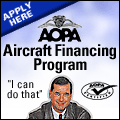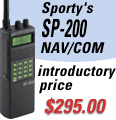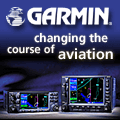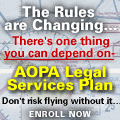| Advertisers
       
Do not reply to this e-mail. Got news? Contact ePilot. Having difficulty using this service? Visit the ePilot Frequently Asked Questions now at AOPA Online or write to [email protected].
Aircraft Owners and Pilots Association
421 Aviation Way
Frederick, MD 21701
Tel: 800/USA-AOPA or
301/695-2000
Copyright � 2001 AOPA. | Training Tips
| THE PERFECT CLIMB
Landings may seem difficult to master–every student struggles with them–but your climb after takeoff requires attention too. The climb to cruise altitude after takeoff is a brief phase of flight, but it requires precise, maximum-performance flying. The brevity of this flight phase did not keep it from accounting for more than 23 percent of accidents in fixed-gear, single-engine airplanes during 1999. Click here to download the AOPA Air Safety Foundation's Nall Report.
 The goals of a proper climb are simple: reach a safe altitude quickly, then continue with maximum efficiency (and occupant comfort) until level-off. This may require several steps. If departing from a short or obstructed runway, employ Vx, best angle-of-climb speed, until clear of obstructions. Then transition to Vy, best rate-of-climb speed, until reaching a height above the ground from which it would be possible, based on your emergency training in the aircraft, to reverse course and land after power loss. After achieving safe altitude, continue at Vy or accelerate to a cruise-climb speed that trades some vertical performance for better engine cooling. Understand that many airplanes' pilot operating handbooks provide these V speeds for maximum gross weight only. Do you know how to adjust the speed for the weight of your aircraft for today's flight? Review this and other rules of thumb. During practice, focus on keeping your airspeed within plus 10 or minus 5 knots of the appropriate speed and you will satisfy private pilot flight test standards. Click here to download the standards. The goals of a proper climb are simple: reach a safe altitude quickly, then continue with maximum efficiency (and occupant comfort) until level-off. This may require several steps. If departing from a short or obstructed runway, employ Vx, best angle-of-climb speed, until clear of obstructions. Then transition to Vy, best rate-of-climb speed, until reaching a height above the ground from which it would be possible, based on your emergency training in the aircraft, to reverse course and land after power loss. After achieving safe altitude, continue at Vy or accelerate to a cruise-climb speed that trades some vertical performance for better engine cooling. Understand that many airplanes' pilot operating handbooks provide these V speeds for maximum gross weight only. Do you know how to adjust the speed for the weight of your aircraft for today's flight? Review this and other rules of thumb. During practice, focus on keeping your airspeed within plus 10 or minus 5 knots of the appropriate speed and you will satisfy private pilot flight test standards. Click here to download the standards.
You have been monitoring altimeter readings, but are they accurate? They will be if, before takeoff, you remembered to set the current pressure into the altimeter's so-called Kollsman window, and compared the reading to the field elevation. Or, if no altimeter setting was available, you set the altimeter to the field elevation. But stay mindful of two facts: if either the temperature or humidity (or both) is unusually high, airplane performance will suffer; the pilot must adjust expectations for the higher density altitude. Also, if expecting pressure changes en route, get new altimeter settings frequently to ensure accurate altimeter readings at all times. See Lies Altimeters Tell .
| Accessing AOPA Online
| As an AOPA Flight Training Trial Member, you have access to all of the features within AOPA Online. If you have received a copy of the magazine or your membership credentials in the mail, log in using your eight-digit member number, which is also your username. If you have not yet received your number, please call AOPA Member Assistance at 800/872-2672 weekdays between 8:30 a.m. and 6 p.m. Eastern for assistance.
| Flight Training News
| MILITARY APPROVES TEXAN II FOR TRAINING
Here's one trainer that will blow the drawers (cowl flaps?) right off your average general aviation single: the Raytheon T-6A Texan II. The military has approved full-rate production for the tandem-seat, single-engine turboprop T-6A. A computer between the power lever in the cockpit and the engine adds in a bit of hesitation to power changes to simulate how a jet engine responds–all in an effort to prepare military pilots for flying fighters. The U.S. Air Force and the Navy are expected to buy nearly 800 of these aircraft for training through the year 2017. Raytheon also developed a comprehensive ground-based training system.
MEANWHILE, ON YOUR RAMP
The XL-2 two-seat sportplane/trainer is in final design form, according to its manufacturer, Liberty Aerospace Inc. Final changes include increased fuel capacity, from 22.5 gallons to 28 gallons, reflecting the increased fuel consumption of the Teledyne Continental IOF-240 that replaced the Rotax engine in the original plans. This increase maintains the XL-2's range "well in excess of 500 nm," according to a company spokesman. Liberty expects a demonstrator aircraft to be available by April 2002, with type certification next fall. Base price for the XL-2 is $105,000. See the Web site.
| Inside AOPA
| AOPA HELPS TO END ENHANCED CLASS B
The FAA late Wednesday issued a notam announcing the nationwide elimination of enhanced Class B (ECB) airspace from 30 major metropolitan areas. The notam also reduced the size of the temporary flight restrictions (TFRs or "no-fly" zones) around New York City; Washington, D.C.; and Boston. Except for those three TFR areas, all VFR operations in Class B airspace may resume. In addition, three Washington, D.C.-area airports–Freeway, Maryland, and Suburban airports in Maryland–-may now reopen. "AOPA is thrilled that its close work with the FAA, Department of Transportation, Department of Defense, and Homeland Security officials has resulted in this much-needed relief for general aviation," said AOPA President Phil Boyer. "These changes are a clear indication that things are finally getting back to normal in the national airspace system. This is the most significant step forward since the initial resumption of limited VFR operations on September 19." For depictions of the current TFR areas and updated airspace information, see AOPA Online.
ASF AWARDS SCHOLARSHIPS
Seven college students in 2001 received separate scholarships totaling $11,500 from programs administered by the AOPA Air Safety Foundation. Entries are now open for aviation students seeking scholarships in 2002. See AOPA Online.
Changing your mailing or e-mail addresses? Click here to update.
| Training Products
| BOOK OFFERS ATC, WEATHER TIPS
In his new edition of ATC and Weather: Mastering the System, author Richard Collins tells pilots how to work air traffic control and weather information services to their best advantage. He emphasizes judgment and the interface between pilots and their environment, addressing both VFR and IFR issues from flight planning to arrival and landing. The book is available from Aviation Supplies and Academics for $19.95; visit the Web site or call 800/426-8338.
| Final Exam
| Question: What is the difference between best rate of climb speed and best angle of climb speed?
Answer: The best rate of climb speed (known as Vy) provides the greatest gain in altitude in the least amount of time. The best angle of climb speed (known as Vx) provides the greatest gain in altitude in a given distance. The different airspeeds that either limit or result in specific aircraft performance are known as "V" speeds–V for velocity. The different v-speed abbreviations are listed in 14 CFR 1.2. For more information on all the v-speeds and their effect on aircraft safety and performance, see AOPA Online.
Got a technical question for AOPA specialists? E-mail to [email protected] or call 800/872-2672.
| What's New At AOPA Online
| Curious about instrument approach procedures? You can download the approach procedures for your airport or any other from AOPA Online. These current charts are perfectly legal for flight, make a great study aid, and can satisfy your curiosity about those strange terms instrument pilots are always discussing. What is a "decision height" anyway?
| Picture Perfect
| | Jump to the AOPA Online Gallery to see the featured airplane of the day. Click on the link for details on how to capture wallpaper for your work area. See AOPA Online. | ePilot Calendar
| Check your weekend weather on AOPA Online.
WEEKEND FLYING DESTINATIONS
Chino, California. The Air War over North Africa is a featured presentation at the Air Museum Planes of Fame January 5. Call 909/597-3722 for event information.
Lawrenceville, Georgia. A pancake breakfast takes place January 5 at Briscoe Field (LZU). Call 770/613-9501 for event information.
For more airport details, see AOPA's Airport Directory Online . For more events, see Aviation Calendar of Events
ASF FLIGHT INSTRUCTOR REFRESHER CLINICS
(All clinics start at 7:30 a.m.)
The next AOPA Air Safety Foundation Flight Instructor Refresher Clinics are scheduled in Long Beach, California; Charlotte, North Carolina; and San Antonio, Texas, January 5 and 6. For the Flight Instructor Refresher Clinic schedule, see AOPA Online.
ASF PINCH-HITTER GROUND-SCHOOL COURSES
(Pinch-Hitter courses start at 9:30 a.m.)
The next Pinch-Hitter(R) Ground Schools will take place January 6 in Long Beach, California, and San Antonio, Texas. For more Pinch-Hitter courses, see AOPA Online.
ASF SAFETY SEMINARS
AOPA Air Safety Foundation Safety Seminars are scheduled in Oakland, California, January 7; Santa Rosa, California, January 8; Sacramento, California, January 9; and Fresno, California, January 10. The topic is Spatial Disorientation. For more information, visit the Web site.
For comments on calendar items or to make submissions, contact Julie S. Walker at [email protected].
| |